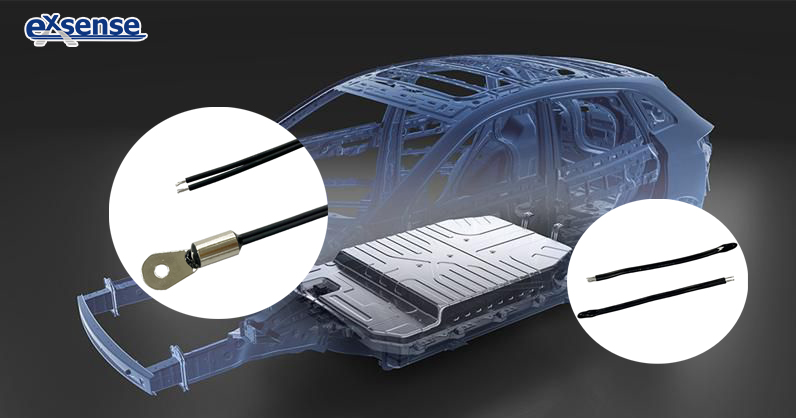Reliable NTC Temperature Sensor – The “Safeguard” for Automotive Batteries
Driven by the global energy transition and the “dual-carbon” policy, the automotive industry chain is rapidly evolves from fuel-driven to electrified. As a core component of energy vehicles (EVs), the thermal management system of power batteries directly impacts vehicle range, service life, safety, and reliability. Within this system, the NTC temperature sensor plays a crucial role as the core sensing element. Monitoring battery cell temperature changes in real-time provides multi-dimensional data support to the Battery Management System (BMS). This prevents safety hazards like thermal runaway, ensuring safe operation throughout the vehicle’s entire lifecycle.
EVs on the market predominantly use lithium-ion power battery systems. The optimal operating temperature range for lithium-ion batteries is 25-40°C. Prolonged operation outside this safe range leads to performance degradation and safety risks. Experimental data shows that sustained high temperatures can reduce battery cycle life by over 50% and decrease power output capability by approximately 30%. When temperatures climb above 80°C, electrolyte decomposition reactions can trigger a chain exothermic process, potentially escalating into a thermal runaway event. Therefore, precise temperature control of batteries is critical. The following sections provide a detailed analysis focusing on battery structure, temperature control methods, and installation methods:
Ⅰ.Structure of Automotive Battery Packs and Thermal Management Systems
- Battery Pack Structure:The battery pack comprises the pack casing, upper heating films, lower heating films, multiple upper battery cells, and multiple lower battery cells. Numerous battery cells form modules, and various modules constitute the battery pack.
- Thermal Management System:This includes the Battery Management System (BMS), water pump and pump controller, inlet water temperature sensor, and multiple battery temperature sensors. NTC temperature sensors are primarily installed above each battery cell, at the pack’s centre, or on the pack’s sidewalls. This ensures accurate monitoring of each cell’s temperature, preventing safety incidents.
Ⅱ.How do NTC sensors control battery pack temperature?
As the core sensing element of the battery thermal management system (BMS), the NTC temperature sensor establishes a robust safety barrier for the battery pack through precise temperature monitoring.
- Real-time Temperature Monitoring:NTC temperature sensors are fixed onto the surface of battery cells within the battery module structure. They monitor temperature changes in real-time (response time < 300ms), converting resistance signals into voltage signals and transmitting them rapidly to the BMS. When the internal battery temperature rises continuously to 55°C, the NTC sensor immediately triggers the BMS to activate the liquid cooling protection mode, controlling the temperature within the safe range via heat exchange. When the NTC detects temperatures below 5°C in low-temperature environments, it activates PTC heaters for pre-heating, ensuring the battery reaches a suitable operating temperature before charging.
- Thermal Runaway Warning & Tiered Protection:The high precision of NTC temperature sensors (±0.3°C) enables them to detect abnormal temperature rise rates in cells. When the temperature reaches the critical threshold of 70°C, the BMS immediately executes emergency protection strategies, reducing charging power and activating intensive cooling. If the temperature rises beyond 85°C, the main relay is cut off, a safety alarm is triggered, and the spread of thermal runaway is contained. Case studies from EV brands show that automotive-grade NTC sensors (rated for 125°C and IATF 16949 certified) can provide thermal runaway warnings more than 30 seconds in advance.
- Efficiency Optimisation & Life Management:Real-time temperature data from NTC sensors assists the BMS in implementing dynamic control. Internal cell temperatures are typically 3°C higher than usual during fast charging. The BMS uses NTC feedback to adjust charging current distribution, preventing localised overheating that causes uneven battery capacity degradation. Data indicates that precise temperature control can extend battery life by 20% to 30% and reduce range fluctuation by 5%.
Ⅲ.What Installation Methods are Used for NTC Temperature Sensors?
To meet the stringent temperature control requirements of EV batteries, the following two installation methods are commonly used:
- Epoxy Resin Encapsulation & Surface Mount:The epoxy-encapsulated sensor is adhered to the battery pack surface using silicone.
- Metal Ring/Tab Mounting:Typically housed in a ground ring type enclosure, the sensor is fixed to the battery pack surface using screws or laser welding.
- Currently, considering monitoring stability, more manufacturers opt for the metal ring/tab mounting. This method also suits components like transformers, inverters, charging ports, and the BMS, offering high-pressure resistance and stability advantages.
Ⅳ.Technological Advancements & Industry Trends
Automotive-grade NTC sensors are currently evolving towards miniaturisation, higher reliability, and enhanced precision:
- Packaging Breakthroughs:Using epoxy packaging technology (e.g., EXSENSE’s VT series), NTC chip thickness is reduced, with the VT head measuring ≤2.7mm to fit the limited space within individual cells.
- Redundancy Design Application:High-end vehicle battery packs now employ dual NTC sensors in parallel. If the primary sensor fails, the redundant sensor automatically connects to continue monitoring, ensuring vehicle operational safety.















.jpg)
